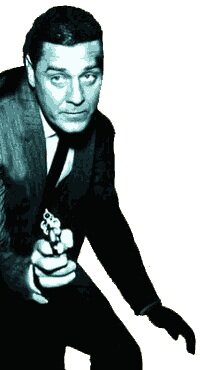You are hereMagazines 2000-2009 / Peter Gunn
Peter Gunn
 Craig Stevens.
Craig Stevens.
PETER GUNN
Sets 1 & 2
A & E Home Video
from SCARLET STREET, 2002
The plots aren’t much, nor does gumshoe Peter Gunn (Craig Stevens) do much detecting -- he seems to rely more on hunches and convenient confessions -- but plots and detective work aren’t why you’d watch the 1958-61 TV series PETER GUNN. This visually distinctive series (shadowy TV noir at its best) was created by up-and-coming film auteur Blake Edwards (THE PINK PANTHER, BREAKFAST AT TIFFANY’S), who here first united with up-and-coming smooth jazz composer Henry Mancini (THE PINK PANTHER, BREAKFAST AT TIFFANY’S, TOUCH OF EVIL). The two make a formidable pair, giving this 114-episode series an unusual edge.
PETER GUNN is nominally about detective Gunn, the well-dressed, super-cool P.I., who never seems fazed by anything. But it is really about recycling Dashiell Hammett/Raymond Chandler-style goings-on through a TV screen darkly. Mancini’s syncopated rhythms, smooth and dreamy, reflect the bizarre world of Gunn and his cronies, which is always seen at night, late at night. In fact, Gunn wears the evening like a suit of clothes -- you never see him during the day -- and is always immaculately dressed in a dark business suit, his hair rarely mussed, his coolness never disturbed.
There is a family of regulars the gumshoe encounters on almost every case: the nightclub hostess known only as Mother (Hope Emerson), who runs (naturally) “Mother’s,” Gunn’s unofficial office; the lounge singer/girlfriend Edie (Lola Albright), who is perennially smiling, waiting, and hoping for Pete to choose her over a case; and the grouchy- but-always-there-in-a-pinch Lt. Jacoby (Herschel Bernardi), who consistently seems to be one step behind Gunn all the way.
And the mysteries? Many of the episodes are either written or directed by Edwards, and reflect his obsession with those mean streets that Chandler’s Phillip Marlowe strode. The stories usually start off with a bizarrely intriguing killing, such as the offbeat opening of “The Blind Pianist.” In that, a blind jazz pianist plays at a nearly empty nightspot while the sole patron, a young woman in an evening dress, is strangled to death by a stranger in black gloves (similar openings would later become staples on Britain’s 1961-69 teleseries THE AVENGERS).
The stories also typically revolve around the violent passions lurking beneath the complacency of everyday 1950s life. “Streetcar Jones” finds Gunn investigating the death of a jazz musician, which he solves after attending a night club and listening to jazz; “The Vicious Dog” is about a killer who uses a nasty pooch to go after a newspaperman he disagrees with; “The Kill” features vigilantes dressed as cops (there is also a scene that was duplicated in the Dirty Harry film MAGNUM FORCE); while “The Frog” finds THE TIME TUNNEL’s general, Whit Bissel, as a well-dressed gangster who beats up people with his cane.
Love and death are invariably intertwined in Gunn’s world, with many of the mysteries centering around jealous gangsters who kill rival suitors for a melancholy girl’s affection (“The Chinese Hangman,” “Lynn’s Blues” “Rough Buck”). And, in the best noir tradition, Gunn always loves Edie faithfully but loves danger more. As they are about to kiss, the case inevitably beckons and the gumshoe is off into the night, but not without a wry exchange. She: “They say patience is a virtue” He: “Who?” She: “Patient, virtuous people.” Oh, so cool.
The two-set, four-volume, DVD release features 32 episodes. The quality is fine, about as good as you could expect for a nearly 50-year-old series. There is an interactive Peter Gunn trivia game and, of course, Mancini’s Grammy-winning theme. – Tom Soter
